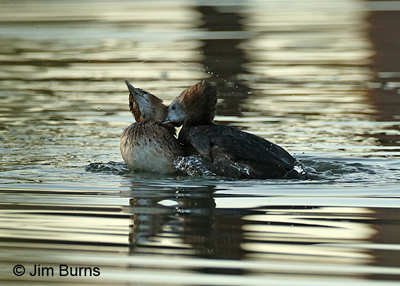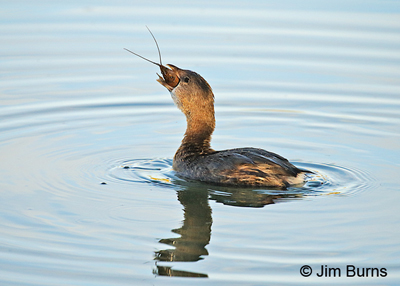
The assailant had come in from behind, startling me and presumably his victim, as he splash glided down, almost beside me, from a low trajectory flight, throwing up furrows of water and thumping into his victim’s body to stop his own momentum. As the adversaries churned and roiled the water, now in the open, now behind a curtain of reeds, one on top, then the other, I dropped to my knees, aimed at the bright ripples surrounding them, and hoped these would provide enough contrast to activate my autofocus.
In the semi-darkness it appeared, and observations later in the day confirmed, that the attacking bird was slightly larger than his adversary and was grabbing and pulling at its nape and neck area. Though conspecific small water birds, perhaps a foot long and weighing a little over a pound, this was brutal combat. In the afternoon, when I watched one of them emerge from the depths with a crayfish, casually position and then swallow it, I had no doubt the heavy, laterally compressed bill, down curved to a small hook, was equipped for and capable of lethal damage.
At home that evening I smiled knowingly to myself as I read Birds of North America’s (BNA) description of Pied-billed Grebe—“The Pied-billed Grebe is an aggressive bird, threatening, chasing, and attacking both members of its own species and other birds.” BNA goes on to describe Pied-bills’ agonistic behavior (no, that is not a typo of “antagonistic”—google it) in these territorial disputes—“. . . jabs with bill trying to get hold of the opponent’s nape or feathers behind the eyes.” Certainly I had witnessed exactly that.
Curious and unable to tear myself away from the possibility of better photographs, I spent the rest of the day at the pond watching from different vantage points while trying to place myself inside the mind of a Pied-billed Grebe. What I saw was half a dozen more chases initiated by the sunrise aggressor, several of them covering nearly the entire length of the eighty yard pond, but none of these ended with actual grebe on grebe contact as the original one had.
The rectangular pond contained two extensive reed beds, one at each end, and three grebes. Two of the grebes, one the victim of the dawn assault, and another hung out together at the south end. The third, the dominant one, stayed mostly at the north end. It was slightly larger and more fully feathered, perhaps an older bird. The victim was easy to spot by virtue of a patch on its nape where the feathers appeared to be missing, perhaps a consequence of the original attack. This bird seemed thinner and less robust, maybe a yearling fledged the past summer. I found myself assuming the combatants were both males, and the third bird, the non-combatant, perhaps a female.
I was surprised at the length of time Pied-billed Grebes can stay under water. On several occasions I saw one of them dive but never saw it come up, then discovered it almost to the other end of the pond minutes later. All three foraged extensively around the pond, but the two from the south end never ventured much past the center, whereas the dominant bird toured the south end with impunity. The chases always occurred when the chaser spotted the chasee near the middle of the pond and came half the distance of the pond to run the second “male” out of the area.
The latter bird became more adept at evasion, typically patter-flying--running across the surface of the water with wings flapping--half the length of the pond, then crash diving and sinking out of sight before the bully could catch up. It will be interesting to see how this relationship plays out going forward into breeding season. Stay posted.